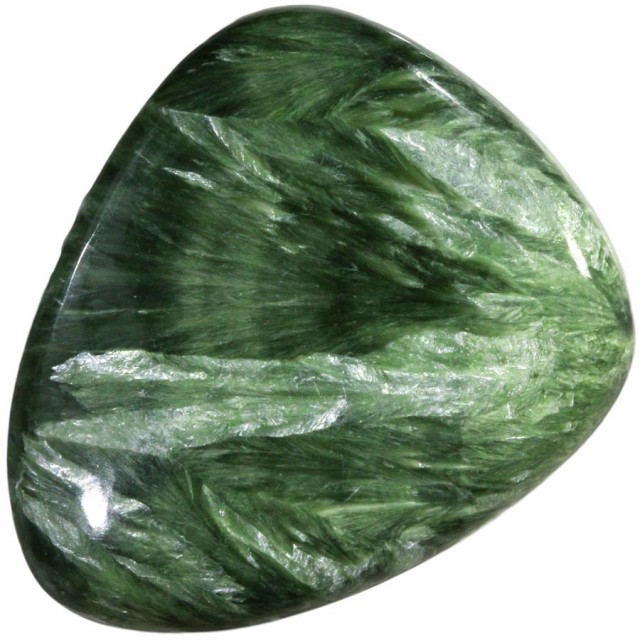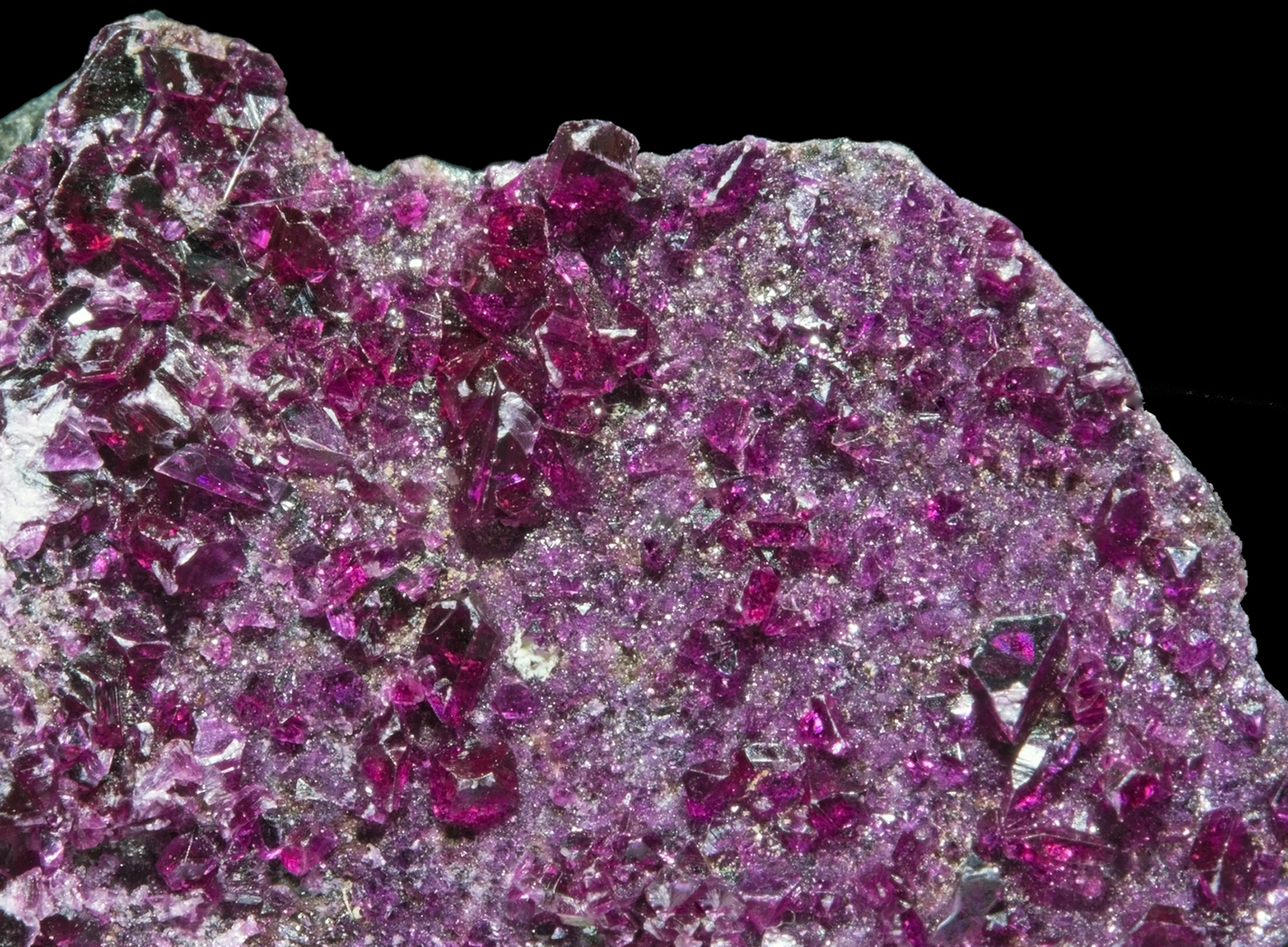
Clinochlore Gemstone: Properties, Meanings, Value & More
 Clinochlore (pronounced KLINE-oh-klore) is a group of chlorite minerals, some of which are cut as gemstones. One popular gemstone variety of clinochlore is seraphinite.
Clinochlore (pronounced KLINE-oh-klore) is a group of chlorite minerals, some of which are cut as gemstones. One popular gemstone variety of clinochlore is seraphinite.
What is the difference between chlorite and clinochlore? Clinochlore is a subgroup of the larger chlorite group — all clinochlores are chlorites, but not all chlorites are clinochlore.
Is clinochlore rare? As a mineral, no. In fact, clinochlore is among the most common types of chlorite. The gemstone forms, however, are rare. They’re mostly known as collector’s gems.
In this guide, we’ll go over all the clinochlore varieties, properties, prices, history, and more!
 Image credit: Rob Lavinsky, iRocks.com – CC-BY-SA-3.0
Image credit: Rob Lavinsky, iRocks.com – CC-BY-SA-3.0
About Clinochlore Stone
“Clinochlore” may refer to a group of chlorite minerals or an individual mineral in that group. The clinochlore varieties used as semi-precious gemstones include seraphinite, kammererite, and sheridanite. Kammererite is an astrological talisman for Virgo and Pisces.
Other names for clinochlore include:
Klinochlor
Clinocloro
Clinochlorite
Grastite
Tabergite
Prochlorite
Chlorophoeite
What colors can clinochlore be? Most clinochlore stones are some shade of green, though you’ll see other colors in varieties like kammererite, which has red to purple hues.
Industrially, what is clinochlore used for? Clinochlore and chlorite stones overall don’t have many industrial uses beyond being in construction stones.
That said, chlorite minerals like clinochlores are often present in clay, which has an abundance of industrial applications. In Iran, a natural clinochlore clay compound made of dolomite, chlorite, and talc is used to make carved stone vessels.
 Image credit: © Raimond Spekking / CC BY-SA 4.0 (via Wikimedia Commons)
Image credit: © Raimond Spekking / CC BY-SA 4.0 (via Wikimedia Commons)
Clinochlore Specifications & Characteristics
The chlorite mineral group encompasses micaceous phyllosilicates with compositions that have iron, aluminum, silicon, and magnesium substituting for each other.
Clinochlore and chamosite are the most common chlorite species. In fact, clinochlore is the magnesium-rich end member in a series with chamosite as the iron-rich end member.
The clinochlore formula can be written as Mg5Al(AlSi3O10)(OH)8 or (Mg,Fe2+)5Al(Si3Al)O10(OH)8, the latter accounting for the frequent presence of ferrous iron.
Other common impurities in clinochlore are manganese, zinc, calcium, and chromium.
Clinochlore crystals can be prismatic or tabular and pseudo-hexagonal. The mineral also occurs as masses that are foliated, flaky, globular, radiating, and/or fibrous.
Iron-bearing clinochlore can have varied levels of oxidation, altering its appearance and optical properties.
Clinochlore’s (general) properties listed:
Mohs hardness: 2-2.5
Color: Green, yellow-green, yellow, olive green, blackish-green, blue-green, white, colorless, pink, red, reddish-purple, purple
Crystal structure: Monoclinic, pseudo-hexagonal
Luster: Vitreous, pearly, greasy, or dull
Transparency: Transparent to opaque
Refractive index: 1.571-1.600
Density: 2.55-3.02
Cleavage: Perfect on {001}
Fracture: Uneven/irregular (on non-cleavage, flat surfaces); Micaceous
Streak: Greenish-white to white
Luminescence: None
Pleochroism: Present; Usually pale yellow-green or pale blue-green to pale greenish-yellow or pale blue-green; Sheridanite: Colorless, pale green, pale yellow-green, pale brownish-yellow; Kammererite: Violet to red
Birefringence: 0.005-0.011
Dispersion: Unknown
Optical phenomena: Chatoyancy (in seraphinite)
With the basics established, what are the different types of clinochlore?
Types of Clinochlore
There are quite a few clinochlore minerals. We’ll start with the non-gemstone types:
Corundophilite: Aluminum-rich variety
Diabantite: Ferroan and silicon-rich variety
Nickel-Bearing Clinochlore: Nickel-bearing variety
Pennine: Trigonal or pseudo-trigonal variety
Penninite: Silica-rich, iron-poor variety
Pycnochlorite / Pyknochlorite: Iron-rich variety
Ripidolite: Historical name for intermediate/unknown minerals in clinochlore-chamosite series OR ferroan variety from Russia
Talc-chlorite: Very silica-rich, aluminum-poor variety; Note: talc is not a chlorite
Onto the gemstones:
Seraphinite

Arguably the most popular clinochlore, seraphinite is a variety with forest-green coloring and light green to silver feather-like, radiating patterns. The patterns come from iridescent mica fiber inclusions, which can cause chatoyancy (the “cat’s eye” effect).
Kammererite
 Image credit: Géry PARENT, CC-BY-SA-4.0
Image credit: Géry PARENT, CC-BY-SA-4.0
Kammererite, or kämmererite, is a chromium-bearing clinochlore variety with red to purple-red, pink, or lilac colors. One of the rarest clinochlores, gem-quality specimens only come from Turkey, though some 2016 cabochons emerged from India.
The stone may resemble charoite, but with a significantly lower Mohs hardness.
Sheridanite
Sheridanite is an aluminum-rich variety named for the stone’s original location: Sheridan County, Wyoming, USA. This variety can be olive green, blue-green, or blackish-green.
Other Clinochlore Gems
 Pictured above: Quartz crystal with golden rutile needles and mossy green clinochlore | Image credit: Rob Lavinsky, iRocks.com – CC-BY-SA-3.0
Pictured above: Quartz crystal with golden rutile needles and mossy green clinochlore | Image credit: Rob Lavinsky, iRocks.com – CC-BY-SA-3.0
Clinochlore can also appear in other gems, namely Burmese jadeite and maw-sit-sit. Both of these stones are rocks, meaning they contain multiple (sometimes varied) minerals, one of which is often clinochlore.
Additionally, some types of quartz with lily pad-shaped clinochlore inclusions, sometimes called “clinochlore quartz,” are fairly popular and attractive.

Clinochlore History
American geologist William Phipps Blake chose the name “clinochlore” in 1851 for specimens found in Pennsylvania, USA. The name derives from the Greek terms klino, meaning “oblique” or “inclined,” and chlōros, meaning “green,” because the minerals were green, tabular crystals with inclined axes (tapered, pyramidal terminations).
Previously, German geologist Abraham Gottlob Werner named clinochlore “chlorite” in 1789, also from the Greek term for “green” mentioned above.
However, clinochlore has been used since prehistoric times, particularly in the Middle East.
Ancient Clinochlore Artifacts
Clinochlore and chlorite minerals were used for thousands of years, particularly in the Middle East, for objects like seals, tombstones, and beads.
Archeologists have found prehistoric artifacts containing chlorite. Some were practical — pipes, bannerstones, gorgets, tubes, spindle-whorls — and many were decorative — like beads, vases, figurines, small vessels, and amulets.
Mesopotamian chlorite vessels found in royal graves and temples dated around the Early Dynastic period (2900 to 2350 BC) were likely luxury items with ritual or funerary importance.
 Pictured above: Cinnamon-colored grossular garnets with green diopside crystals and dark green clinochlore crystals | Image credit: Rob Lavinsky, iRocks.com – CC-BY-SA-3.0
Pictured above: Cinnamon-colored grossular garnets with green diopside crystals and dark green clinochlore crystals | Image credit: Rob Lavinsky, iRocks.com – CC-BY-SA-3.0
Clinochlore Healing Properties
As a mostly green healing stone, clinochlore’s meaning reflects that of other green gemstones, offering rejuvenation, fresh starts, and renewed hope. Clinochlore crystals can be used as chakra stones for balancing the entire chakra system.
Physical Healing
Physically, clinochlore is said to treat issues related to:
Headaches
Muscle stiffness
Sinus infections
Fatigue
Emotional Healing
Emotionally, clinochlore’s metaphysical properties are believed to boost or facilitate:
Creativity
Open-mindedness
Concentration
Stress reduction
Inner peace
Personal growth

Clinochlore Gemstone Properties
Besides rarity, clinochlore gemstone value depends on color, cut, clarity, transparency, and carat weight.
Color
Many collectors seek out emerald-green clinochlore gems. But rare shades like kammererite’s reds and purples are also quite valuable.
Pure clinochlore is colorless or white. Common green shades come from iron impurities. Chromium causes red/pink to purple hues, while other impurities can cause yellow to brown colors.
Cut
Clinochlore is quite soft with perfect cleavage, making faceting difficult. Only seraphinite, kammererite, and sheridanite have been faceted, and faceted options of any of these stones are quite valuable.
Common cuts for the gemstone varieties include:
Seraphinite: Cabochons, carvings, and decorative items
Kammererite: Cabochons, carvings, and rough crystals
Sheridanite: Cabochons and rough crystals
Clarity & Transparency
Clarity, the degree of visible inclusions, can affect a stone’s transparency and value. More transparent clinochlore gems may be more valuable, but inclusions often produce desirable effects, like those in seraphinite.
Clinochlore may be an inclusion in other gemstones, like:
Quartz
Ethiopian emerald
German topaz
Carat Weight & Size
Massive clinochlore specimens can yield fairly large cabochons, but faceted gems are usually small, up to 5 or 6 carats (or for kammererite, up to 2 carats).
Treatments
Treatments aren’t common for clinochlore gems, but some may be wax-treated to increase their durability.
Now, how is clinochlore formed?
 Pictured above: Garnet and clinochlore specimen
Pictured above: Garnet and clinochlore specimen
Clinochlore Formation & Sources
Clinochlore forms when rocks undergo low-grade metamorphism or hydrothermal alteration, transforming minerals inside like amphibole, biotite, and pyroxene into clinochlore.
What type of rock is clinochlore found in? It’s found in many metamorphic or sedimentary rocks like:
Chlorite schists
Zeolite facies
Serpentinites
Marbles
Amphibolites
Basalts
Gabbros
Geographically, where is clinochlore found?
Mining Locations
Attractive clinochlore crystals are mostly found in:
Australia
Austria
Brazil
Canada
Germany
Italy
Mexico
Russia
Scotland
Sweden
Switzerland
Turkey
UK (England)
USA (Arizona, Connecticut, Colorado, Nevada, New Jersey, New York, Pennsylvania, Vermont, Wyoming)
Gem-quality specimens of the gem varieties have fewer sources:
Seraphinite: Siberia, Russia
Kammererite: Turkey; India
Sheridanite: Wyoming, USA
So, how much does clinochlore cost?

Clinochlore Price & Value
Despite their rarity, clinochlore gemstones can be more affordable than you’d think.
Seraphinite is the only faceted option easily found, besides quartz with clinochlore inclusions.
Faceted seraphinites go for about $10 to $15 per carat. Cabochons are generally around $6 per carat, and rough specimens are about $1 per carat. The most expensive options are huge carvings or spheres, which can be $500 to $1,000.
Kammererite is mostly available as cabochons, which are usually around $10 to $25 each. Carvings can be $30 to $200 or higher, depending on complexity and size. Rough crystals range from around $20 to upwards of $400, depending on quality and size.
Rough clinochlore specimens range broadly, from around $2.50 to $400.
Clinochlore Care and Maintenance
In terms of gemstone care, clinochlore gems are pretty fragile. Jewelry-wise, we recommend choosing only pendants or earrings and always opting for protective settings.
The stone is heat-sensitive, so store it in a cool place separate from other gems. You can clean it with lukewarm water, mild soap, and a soft, microfiber cloth.
Inclined to Choose Clinochlore?
Gems named “clinochlore” may seem mundane, but don’t judge a stone by its name! These crystals can have beautiful angelic wings, romantic pink hues, and rejuvenating green colors perfect to refresh any space or outfit.
Search the Gemstone Encyclopedia
Related Auctions
Related Articles
Originally the Birthstones or gemstones were associated with a zodiac sign or the month of a individuals birth. Find out what your stone is and view the stones we have for sale
8th Feb 2021
There are dozens of quartz and chalcedony gems with various colors and patterns. Learn all about quartz properties and every type of quartz, from amethyst and agate to plasma and phantom quartz!
15th Oct 2020
Hackmanite is a pink to violet sodalite gem known for its unique color-change and luminescence. Learn why hackmanite is special, from its rare qualities to the types of hackmanite jewelry available.
28th Mar 2018
Latest Articles
Shortite is a rare mineral and rarer gemstone, usually found as colorless or yellow wedge-shaped crystals. Learn the value, history, and properties of shortite in this guide!
9th Dec 2024
Senarmontite is an uncommon antimony mineral mostly used industrially but occasionally collected as rare gems or pearly crystals. Find out all of the traits, uses, prices, and history of senarmontite.
27th Nov 2024
Tantalite is a group of red, brown, or black minerals containing the rare and valuable element tantalum. Discover the uses, history, prices, and properties of tantalite gemstones in this guide!
11th Nov 2024
Article Categories
How To's is where you will find helpful articles from gem Rock Auctions on how to cut gemstones, select gemstones and buy gemstones.
9 Articles




